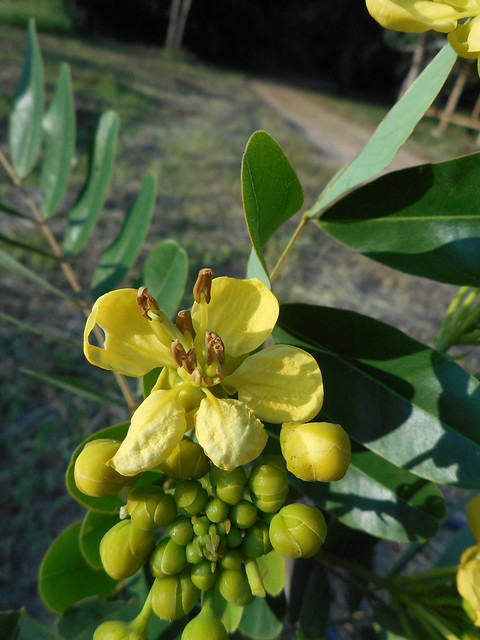What does the term "fall colors" mean to you? When you hear that term, what do you see in your mind?
For many years, the term fall colors would cause me to picture standing on a mountain top in the White Mountains of New Hampshire looking across at the vast and varicolored display of reds and oranges and yellows and greens. Later on in life, living in California, I would think of the non-native oramentals such as Chinese pistache, Chinese tallow and Liquiamber in shades of yellow to purple.
Now, I think of yellow.
For September and October is when the Siamese Cassia bloom in Thailand.

I first recall seeing these blooms when we visited the Changing Life Center in October 2011 for the first Youth Camp they hosted there. There was a tree on the campus that was blooming at the time.
But the Siamese Cassia are only one of many indicators of the passing of time throughout the year. Some indicators are natural such as when certain flowers bloom, when certain fruit are ripe or when birds pass through on migratory cycles.
Some cycles are agrarian in nature such as rice planting season, corn planting season, harvest, etc.
Some cycles are cultural such as memorial holidays or events such as throwing water during Sonkran or setting off fireworks on Independence Day.
Other cycles are religious. Some Christians may look forward to things like Advent or Easter. For the Jew it may be Passover. For the Buddhist it may be Buddhist lent.
Many of the religious and cultural cycles are based on the cycles of the moon.
Furthermore, there are individual cycles such as birthdays and anniversaries.
No wonder many cultures think of time as cyclical instead of linear.
Solomon wrote:
What has been is what will be, and what has been done is what will be done, and there is nothing new under the sun.
Is there a thing of which it is said, “See, this is new”? It has been already in the ages before us.
(Ecclesiastes 1:9-10 ESV)
It takes a while to adjust to the cycles of a new place. The first year you don't notice the cycles because you are new. Perhaps each year you start to notice more and more. Eventually you get used to the cycles and they become part of your norm. Though perhaps if you grow up in a place, you may take the cycles for granted and hardly notice them at all.
Now that we have lived in northern Thailand for 2-1/2 years, we have become used to some of the cycles--especially the fruit cycles. Especially mango season! (Begins about March, peaks in June and July with some varieties carrying on later.)
As we prepare to head back to North America for a few months, part of me is already grieving some of the things I'll miss that we've grown accustomed to such as the cooler, drier weather and the dry-season blooming trees such as flambouyant, Cochlospermum and Tabebuia. But then we will catch the fruit tree blooming period in the Central Valley of California. I'm looking forward to the drive from Fresno to Reedley in peak bloom season! And then there is that annual cultural event of the valley, the International Ag Exposition, which I used to go to every year. There is also the possibility of a white Christmas for us this year.
We don't know what the future holds for us. The cycles we may find ourselves in in the future may be different than what we have grown accustomed to. But one thing doesn't change, and that is God. Jesus Christ is the same, yesterday, today and forever, the writer of Hebrews tells us. (Hebrews 13:8) He is the anchor of our lives, for which we are grateful.
I'm thankful for those rhythms God has placed in our lives. But I'm more thankful that He will still be in my life even when those rhythms are gone.

Thank You for a great message -
ReplyDelete